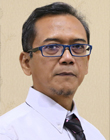TITLE: SURVEILANCE MODEL BASED ON SMART VIDEO SENSOR

Agus Harjoko
Department of Computer Science and Electronics
Universitas Gadjah Mada, Indonesia
This email address is being protected from spambots. You need JavaScript enabled to view it.
Abstract:
Police and the Department of Transportation in Indonesia are still monitoring traffic videos manually. Difficulties arise when traffic problems occur in many places simultaneously. Other difficulties arise when traffic data they receive are incomplete, such as due to missing video frames. As a result, video data is not usable because video data cannot be processed further.
One way to overcome the above problem is by introducing a smart video sensor (SVS) and a processing model based on SVS. The data processing is distributed into three different processing units, the SVS, the Local Processing Unit (LPU) and the Data Center and Control Unit (DCCU). The SVS consists of Sensor Video Module, Video Compression Module, Feature Extraction Module, Feature Representation Module and Data Transmission Module. The video captured by the sensor module is compressed and subsequently transmitted by the transmission module to DCCU. At the same time, the uncompressed video is processed further, and object features are extracted, represented in XML format and transmitted to LPU and DCCU. The extracted features may be used by LPUs and or DCCUs for license plate recognition, traffic control, vehicle tracking, vehicle counting, or ot her purposes. Since the extracted features will be used for many purposes, 39 features are extracted. Many features have more than one values.
The LPU is designed to process extracted object features for its local needs, such as timing local traffic light controller, license plate recognition, or other purposes. For this purpose, the LPU receives features from the SVS, converts the features from XML format to numbers, selects the appropriate set of features based on LPU’s unique needs and processes the selected features. The results may be used for control or other purposes and may be communicated with the DCCU.
The DCCU is designed as the coordinating unit for LPUs in a particular region. As such, it receives object features extracted and sent by the SVS and processes features for regional needs such as synchronizing traffic light controllers, vehicle tracking from one LPU to another, and other purposes. The DCCU also stores compressed video sent by the SVS in case three is a need for legal purposes. For coordination purpose, the DCCU may as well sends signals to LPUs to control how some LPUs behave.
Experiments using traffic data obtained from the local government agencies and data collected by the research team shows that the concept described above is working. The experiments include vehicle counting, vehicle classification and tracking of the classified vehicle. Currently, we are developing a license plate and brand name recognition system which involves convolution features, as well as driver side assistant system.
Keyword – Smart Video Sensor, feature extraction, traffic objects, feature representation, vehicle tracking, distributed processing
Biography
Agus Harjoko is a lecturer and a researcher at the Department of Computer Science and Electronics, Faculty of Mathematics and Natural Sciences, Universitas Gadjah Mada, Indonesia. He is the member of the Indonesian Computer, Electronics and Instrumentation Support Society (IndoCEISS). He received the B.S. degree in Electronics and Instrumentation from Universitas Gadjah Mada, Yogyakarta, Indonesia and the M.Sc and Ph.D. degree in Computer Science both from the University of New Brunswick, Canada, in 1986, 1990 and 1996 respectively. His research interests include signal processing (one dimensional, image, video), computer vision and pattern recognition.
